Non-Ionsing Energy Loss (NIEL) calculation software and verification
Programme
GSTP
Programme Reference
G617-191EE
Prime Contractor
UNIVERSITY OF MILANO BICOCCA
Start Date
End Date
Status
Closed
Country
Italy

Objectives
Develop a robust software for calculation of Non-Ionising Energy Loss (NIEL) for a range of critical space technologies, analyse existing irradiation test data, perform irradiation tests when necessary, map defect centers generated and carry out model verification.
Description
Non-Ionsing Energy Loss (NIEL) is an important radiation degradation-related parameter for a range of spacecraft sub-systems and components including:
- Solar cells.
- Optoelectonic devices.
- Bipolar transistors.
- Imaging instrumentation (star trackers, CCDs, photon detectors).
Under a previous ESA NPI activity, new NIEL models were developed that improve especially the treatment of energetic electrons. This is important for missions flying in high-intensity electron environments such as GEO Telecom missions, navigation systems (Galileo), and science missions such as JUICE. These new models, named SR-NIEL (for Screened Relativistic) utilise the Geant4 software and have recently been included in the ESA Space Environment Information System (SPENVIS).
It is proposed within this activity:
- To consolidate these models and make the necessary developments.
- To implement them as separate software classes within the broadly used Geant4 code as well as in space radiation engineering tools such as GRAS and MULASSIS.
- To extend the models by inclusion of neutron NIEL for ground testing purposes.
- To extend the framework to also treat heavy ions.
- To upgrade the existing software for further implementation of the models.
- To analyse existing NIEL test data.
- To verify the NIEL models by way of irradiation test campaigns (also employing test samples appropriate for DLTS (Deep-level transient spectroscopy) measurements). DLTS techniques will be used to establish defect concentration and their fundamental parameters.
Application Domain
Generic Technologies
Technology Domain
4 - Space Systems Environments and Effects
Competence Domain
10-Astrodynamics, Space Debris and Space Environment
Initial TRL
TRL 4
Target TRL
TRL 7
Achieved TRL
TRL 8
Public Document
